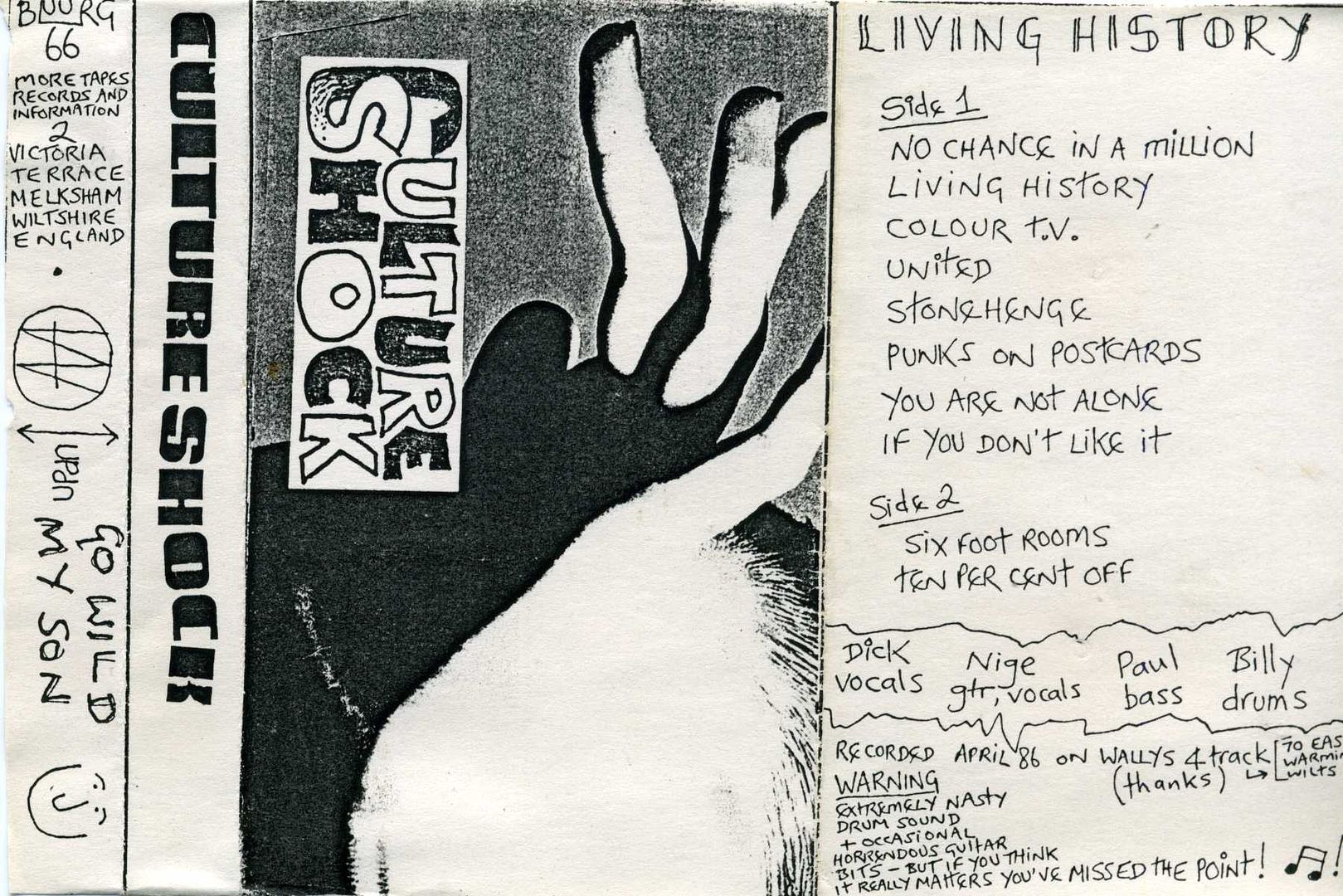
Six Foot Rooms / Ten Per Cent Off
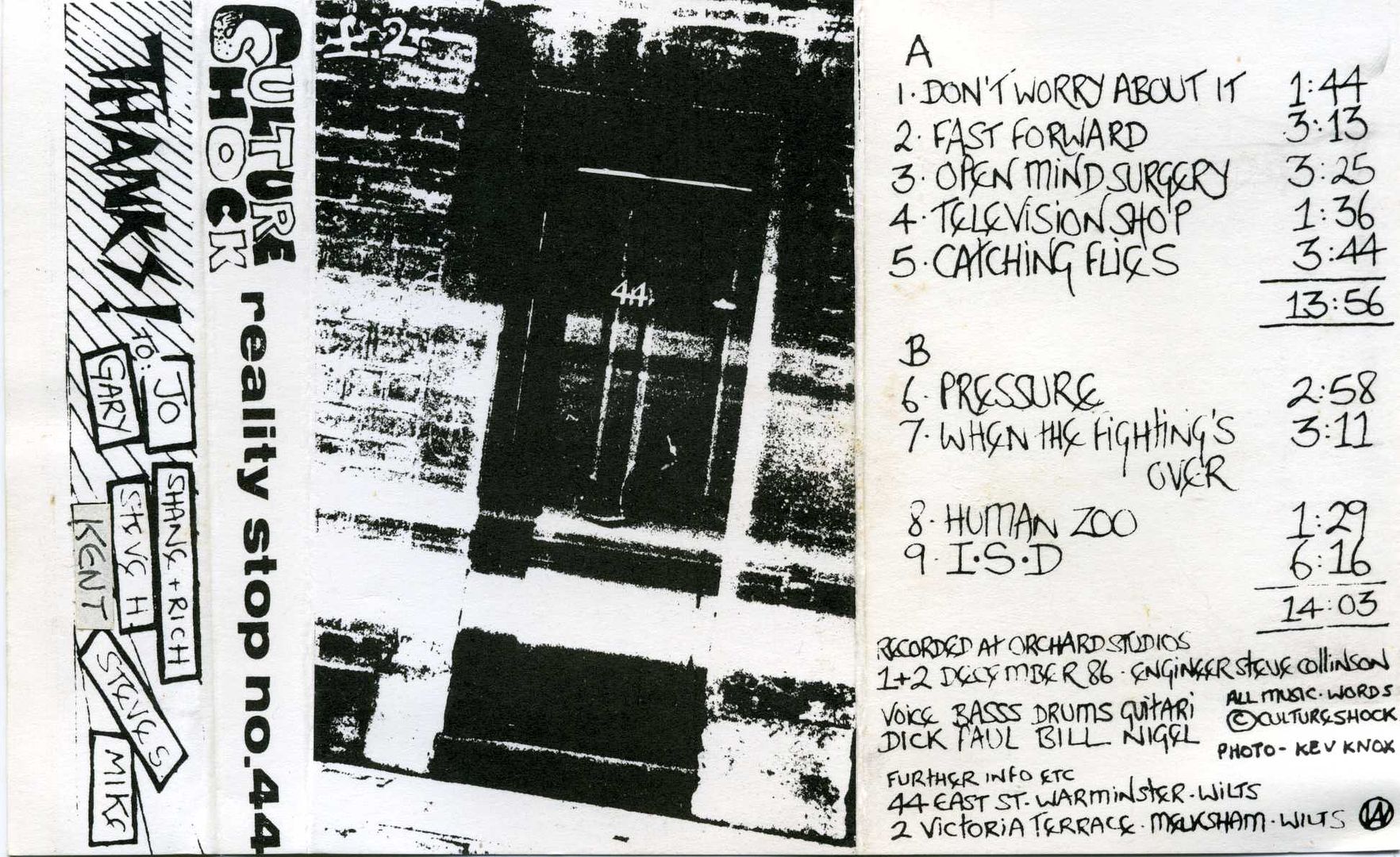
Don’t Worry About It / Fast Forward / Open Mind Surgery / Television Shop / Catching Flies
Pressure / When The Fighting’s Over / Human Zoo / I.S.D.
Uploaded tonight are the two tapes that brought Culture Shock to the public’s attention back in 1986. The band were made up of three separate Wessex bands from the class of 1980, The A Heads, Organised Chaos and The Subhumans. All these bands had disbanded by 1985 and the members created something different and exciting from the ashes. Culture Shock’s vocalist and lyrical guru was Dick Lucas, late of the Subhumans, and later on in the decade vocalist of Citizen Fish. A very intelligent and pleasant man who is still creative in his art and writing today.
Similar to Chumbawumba and Blyth Power, Culture Shock were a great night out at their peak in 1986. Culture Shock lasted only three years or so but in that time played hundreds of gigs all over the place, mainly benefits in squatted venues, Club Dog style events and lots of festivals, specifically around the Stonehenge area at a certain time of year, which by the time of Culture Shock’s lifespan was basically a police state the weeks leading up to and after the summer solstice. Competing only with Blyth Power at this time in the “how many van miles can we possibly squeeze in with this vehicle for the year?” stakes…The band always seemed to get great receptions at the gigs they performed at, at least all the times I saw them they did which was a hefty amount in 1986 and all through the following year. The band were tied into performing gigs with like minded souls like Shrapnel, 2000 DS, Back To The Planet, Life Cycle and A.O.S.
Culture Shock were known for the catchy punky-reggae tunes, a genre which was soon to become bigger with U.S. bands like Operation Ivy and Rancid flying the flag stateside towards the tail end of the 1980′s and early 1990′s. Culture Shock had a bassist who performed in a seriously laid back manner, the rest of the band were well energetic in comparison, and the whole live performance for a bunch of ‘heads’ was surprisingly clear and tight from start to finish. The guitarist Nige died in 1993 (well after Culture Shock had split up) which was sad. Culture Shock left us with these couple of tapes, some tracks on compilation singles and three LP’s which is not a bad output for a band that performed almost all year round solidly for three years!
The two cassette tapes uploaded tonight have been salvaged from my big box of tapes and unfortunately the first couple of minutes of the first side of the first tape is slightly damaged aurally. Sorry about that.
On the text written out below we go back in history to the Battle Of The Beanfield which took place on June 1st near the summer solstice of 1985. The event happened before Culture Shock were formed but the text gives a view of the way the police and other authorities were tackling travellers, sound system owners and free thinkers in those days. During the three years the band existed, Culture Shock’s mission, along with other bands and individuals, was to reclaim this sacred site for the summer and winter solstice celebrations.

Before the trouble started
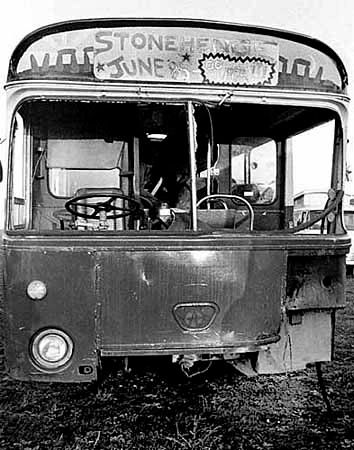
After the trouble finished
Name: Alan Lodge
Date: 1 June 1985
Place: Wiltshire
Facts: Photographer and ambulanceman Alan Lodge was in a convoy of travellers heading for Stonehenge when 1,600 policemen violently tried to arrest them all. Dubbed the ‘Battle of the Beanfield’ in the media, it fragmented the travelling community. Although he subsequently gained a degree, Lodge has since struggled to find work
People don’t like travellers – we lower their house prices – but we hadn’t shown any violence. The police had previous, but the Stonehenge ambush was caught on camera and Dixon of Dock Green don’t do this kind of thing, so there were articles as far away as the Tehran Times.
The first free festival I went to was in the Queen’s back garden at Windsor in 1972. Basically, you’re hanging out with your mates and everyone’s smiling. That carried on until 1974, when 600 Thames Valley police waded in. I was sat round the fire with a cup of tea and suddenly – whoop! A truncheon round the head. We got the message, we were scared stiff, so the People’s Free Festival moved to Stonehenge.
I could see the way the wind was changing so I became an ambulanceman and got involved with an organisation set up to help youngsters who had got in trouble with the law. First in tents and teepees, and then on buses and trucks, people were now permanently meandering around the country. I had a cottage in Wales with my wife and two kids, and we were out and about for roughly nine months of the year.
By the 1984 festival there were 30,000 or 40,000 people at Stonehenge living in tents. Everything you look for in human exchange was there: lack of greed, co-operation, looking out for each other, breaking down mental barriers. Bartering was important. People were grateful for me being an ambulanceman: ‘Can I do your shopping? Can I look after your kids?’ Everything you think about being in a better society was there in the Anarchists’ Free State of Albion at Stonehenge.
On our way there the next year we were given papers by the police outside Salisbury stating that we’d be arrested if we went to Stonehenge because of an injunction they had taken out. We were used to this – the existence of the travelling life is an offence – but we didn’t know this meant they’d assembled 1,600 policemen on our route. The convoy stopped adjacent to the famous beanfield, well outside the five-mile radius of the court order, so I hopped out of the cab to take some pictures. Suddenly I saw this black cloud coming down the line, a load of coppers with riot shields. They went up to the motors, many with kids in, and were whacking them with their sticks. Two pregnant ladies were dragged out of the broken windscreens by their hair. The screams are with me now.
Rather than let them come our way we turned and drove through the hedge into the field by the road. For the next five hours there was a stand-off, skirmishes continued with people trying to get out of the field. I tried to liaise with senior policemen but their attitude was, ‘We’re going to arrest you all.’ I’m bandaging bleeding heads, but then there’s truncheon wounds where you can see the skull and I’m getting nervous of people dying. So we get them out on a Wiltshire ambulance.
At seven in the evening all the coppers boiled on to the field, smashing up the vehicles and arresting everyone. ITN were there and took footage of the level of violence. The operation wasn’t just about arresting people, but also part of a ‘decommissioning exercise’, hitting people so hard and ruining their homes so they’ll think twice about leading this lifestyle. Overall, 520 were arrested and spread around police stations up and down the country for three days, the biggest single number since the Second World War. Children were put temporarily in care. The charge was ‘obstruction of police’, which is one up from a parking ticket. The government was cheering on from the sidelines. Douglas Hurd said we resembled a bunch of medieval brigands.
I thought, ‘I’m a British citizen whose tribe’s been treated badly, we can go through the courts.’ We got 24 together to take an action against the police. Five years later, the jury awarded us £25,000 damages but the judge said we’ll split the £7m cost of the case in half, so our damages went towards that. Two of the jury burst into tears.
In 1986 parliament passed an act which criminalised 12 vehicles gathering on common land to reside. So we’d gather, stay up all night and have a rave instead. In 1994 Michael Howard’s act made this impossible, and then this last lot pass a law that means a traveller parked on the edge of a housing estate is involved in antisocial behaviour. So now a lot of people are shoved into the city where the community splits up, they can’t support each other and the kids have chips on their shoulders. The return to the cities hastened the use of serious drugs.
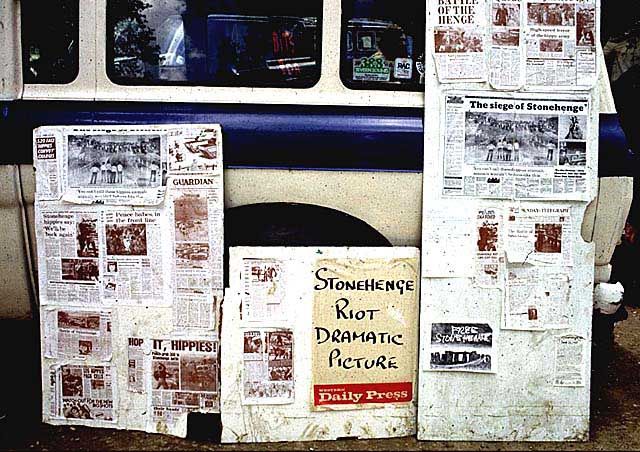
It’s over 25 years since the major trashing of my community, travelling on the way the make the “Peoples Free Festival of Albion” at Stonehenge. It was a regular event on the calender.
This is my account, of the events that day, and its aftermath …….
They said: something had to be done! Stonehenge appeared central to the situation. Police “Operation Solstice” was initiated.
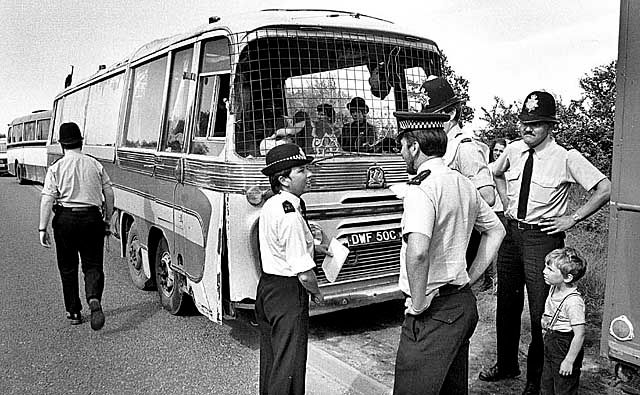
At a meeting of the Association of Chief Police Officers (ACPO), in early 1985, it was resolved to obtain a High Court Injunction preventing the annual gathering at Stonehenge. This was the device to be used to justify the attack at the “Battle of the Beanfield” on the 1st June in Hampshire. Well it wasn’t a battle really.
It was an ambush.
It was a magnificent convoy stretching and snaking its way over the Wiltshire Downs, as far as you could see in either direction. It was a warm Saturday afternoon as we drove through villages, people stood outside their garden gates, smiling and waving at us. A carnival atmosphere with little evidence of the ‘local opposition’ that we had been lead to believe was one of the reasons for obtaining the court orders.
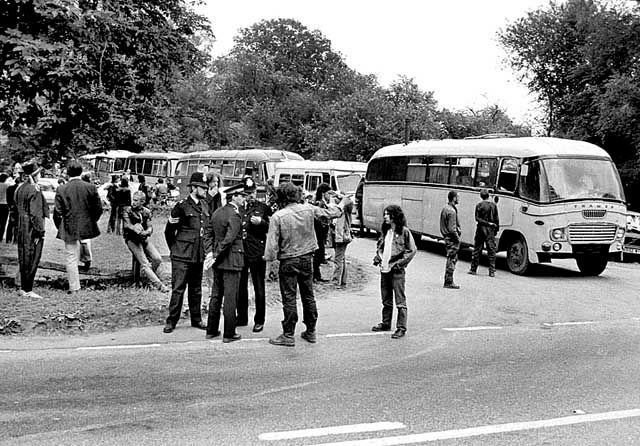
A police helicopter watched overhead but there was little other sign of trouble until……..
Seven miles from Stonehenge (the exclusion order was for four and a half miles), just short of the A303 and the Hampshire / Wiltshire border, two lorry loads of gravel where tipped across the road. Up to this point, no laws had been broken. I got out of my truck to take photographs when I first saw some twenty policemen running down the convoy ahead of me smashing windscreens without warning and ‘arresting’ / assaulting the occupants, dragging them out through the windscreens broken glass.
I and others who saw this were fearful of the level of violence used by the police in making arrests. Clearly we were in for a beating, again! Running back to our vehicles, we drove through a hedge in to the adjacent field.
The scale of the police operation was becoming obvious. The same level of violence had been applied to the rear of the convoy. Large numbers of police in many lines deep could be seen on the road forming up.
From then on, the situation grew more tense. More police reinforcements were brought up wearing one-piece blue overalls – without numbers!, ‘Nato-style’ helmets with visors and both full length perspex shields and circular black plastic shields. A ‘stand-off’ situation developed with sporadic outbreaks of violence.
Working with the festival welfare agencies, I was directed to a number of head injuries that has resulted from the initial conflict on the road. All of these injuries were truncheon wounds to the back of the head and some people were quite distressed. I was shown one man, about 20 years old who was semi-conscious with yet another head wound. I was fearful of him dying. An ambulance was called and I assisted the attendant and helped convey the casualty through police lines. The ambulance crew were initially apprehensive about their safety but assurances were given.
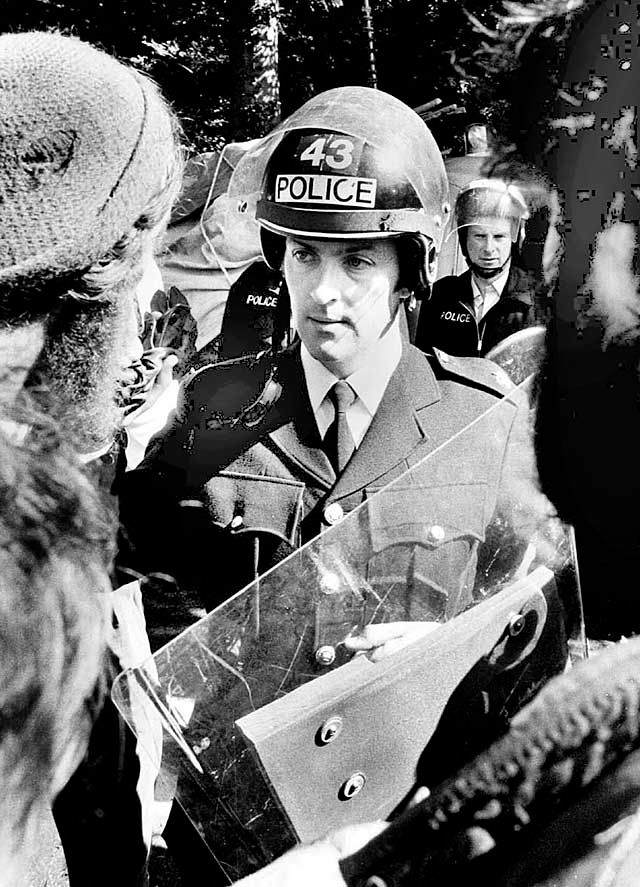
In between the taking of photographs, the copious first aid and concerns for my family and friends, I attempted to start negotiations and set up lines of communications with the middle-ranking ‘line’ officers. There was no ‘middle ground’ to be found, so, with others I organised a meeting with Assistant Chief Constable Lional Grundy. He was in charge of the overall operation. It was early evening before we were able to meet him. The tone of the meeting was ‘do what your told or else!’ He reiterated that people should be leave their vehicle and be arrested.
Because of the fear of what that might intail (after viewing the violence earlier in the day), those I met with were reticent about this. I met Grundy again a little later and attempted to reason further with him, but the ACC then threatened to arrest me for obstruction if I persisted.
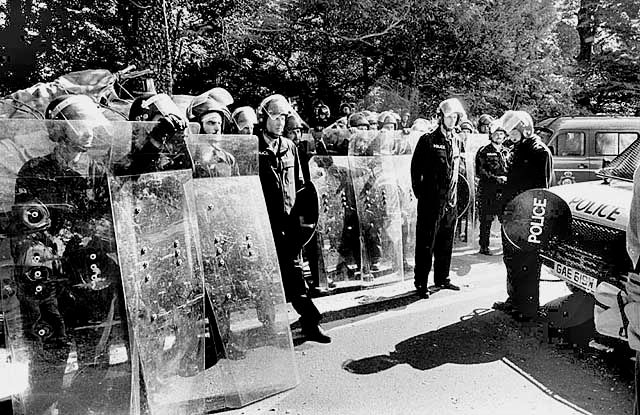
Police in full kit were now massed in large numbers and obviously getting ready to charge. It turns out that police had been arresting a lot of people around Stonehenge earlier in the afternoon. At 7.00pm, Grundy had sixteen hundred policemen from six counties, Ministry of Defence police and some believe, army officers in police uniforms!!!
They had been briefed that we were all violent anarchists rather than a bunch of young people and families with children.
They charged.
The scenes that followed were recorded by media that had evaded the police blockade. The story was international news. ‘Dixon of Dock Green’ type policing was dead. That which Britain was noted for had now changed to para-military operations against minority groups.
Kim Sabido of ITN, a reporter used to visiting the worlds ‘hot spots’ did an emotional piece-to-camera as he described the worst police violence that he had ever seen.
“What we – the ITN camera crew and myself as a reporter – have seen in the last 30 minutes here in this field has been some of the most brutal police treatment of people that I’ve witnessed in my entire career as a journalist. The number of people who have been hit by policemen, who have been clubbed whilst holding babies in their arms in coaches around this field, is yet to be counted…There must surely be an enquiry after what has happened today”.
There wasn’t.
When the item was nationally broadcast on ITN news later that day, Sabido’s voice-over had been removed and replaced with a dispassionate narrator. The worst film footage was also edited out. When approached for the footage not shown on the news, ITN claimed it was missing. Sabido said.
“When I got back to ITN during the following week and I went to the library to look at all the rushes, most of what Id thought wed shot was no longer there,” recalls Sabido. “From what I’ve seen of what ITN has provided since, it just disappeared, particularly some of the nastier shots.”
Some but not all of the missing footage has since surfaced on bootleg tapes and was incorporated into the Operation Solstice documentary shown on Channel Four in 1991.
Public knowledge of the events of that day are still limited by the fact that only a small number of journalists were present in the Beanfield at the time. Most, including the BBC television crew, had obeyed the police directive to stay behind police lines at the bottom of the hill “for their own safety”.
One of the few journalists to ignore police advice and attend the scene was Nick Davies, Home Affairs correspondent for The Observer. He wrote:
“There was glass breaking, people screaming, black smoke towering out of burning caravans and everywhere there seemed to be people being bashed and flattened and pulled by the hair….men, women and children were led away, shivering, swearing, crying, bleeding, leaving their homes in pieces…..Over the years I had seen all kinds of horrible and frightening things and always managed to grin and write it. But as I left the Beanfield, for the first time, I felt sick enough to cry.”

During the charge, I took photographs, but I put my camera away. My (ex) -wife and I comforting and cuddles with each other for fear, before we were attacked..
530 were arrested that day (both at the Beanfield and at Stonehenge), the most in any operation since the Second World War.
Photographic evidence is scant because of the nature of the action. Ben Gibson, a freelance photographer working for The Observer that day, was arrested in the Beanfield after photographing riot police smashing their way into a Traveller’s coach. He was later acquitted of charges of obstruction although the intention behind his arrest had been served by removing him from the scene. Most of the negatives from the film he managed to shoot disappeared from The Observers archives during an office move.
A friend and fellow photographer Tim Malyon narrowly avoided the same fate:
“Whilst attempting to take pictures of one group of officers beating people with their truncheons, a policeman shouted out to get him and I was chased. I ran and was not arrested.”
Tim Malyon’s negatives have also been lost with only a few prints surviving.
One unusual eye-witness to the Beanfield nightmare was the Earl of Cardigan, secretary of the Marlborough Conservative Association and manager of Savernake Forest (on behalf of his father the Marquis of Ailesbury). He had travelled along with the convoy on his motorbike accompanied by fellow Conservative Association member John Moore. As the Travellers had left from land managed by Cardigan, the pair thought “it would be interesting to follow the events personally”. Wearing crash helmets to disguise their identity, they witnessed what Cardigan described to Squall as `unspeakable’ police violence.
Cardigan subsequently provided eye-witness testimonies of police behaviour during prosecutions brought against Wiltshire Police.
These included descriptions of a heavily pregnant woman “with a silhouette like a zeppelin” being “clubbed with a truncheon” and riot police showering a woman and child with glass. “I had just recently had a baby daughter myself so when I saw babies showered with glass by riot police smashing windows, I thought of my own baby lying in her cradle 25 miles away in Marlborough,” recalls Cardigan.
After the Beanfield, Wiltshire Police approached Lord Cardigan to gain his consent for an immediate eviction of the Travellers remaining on his Savernake Forest site.
“They said they wanted to go into the campsite `suitably equipped’ and `finish unfinished business’. Make of that phrase what you will, says Cardigan. “I said to them that if it was my permission they were after, they did not have it. I did not want a repeat of the grotesque events that I’d seen the day before.”
Instead, the site was evicted using court possession proceedings, allowing the Travellers a few days recuperative grace.
As a prominent local aristocrat and Tory, Cardigans testimony held unusual sway, presenting unforeseen difficulties for those seeking to cover up and re-interpret the events at the Beanfield.
In an effort to counter the impact of his testimony, several national newspapers began painting him as a `loony lord’, questioning his suitability as an eye-witness and drawing farcical conclusions from the fact that his great-great grandfather had led the charge of the light brigade. The Times editorial on June 3rd claimed that being “barking mad was probably hereditary.”
As a consequence, Lord Cardigan successfully sued The Times, The Telegraph, the Daily Mail, the Daily Express and the Daily Mirror for claiming that his allegations against the police were false and for suggesting that he was making a home for hippies. He received what he describes as “a pleasing cheque and a written apology” from all of them. His treatment by the press was ample indication of the united front held between the prevailing political intention and media backup, with Lord Cardigans eye-witness account as a serious spanner in the plotted works:
“On the face of it they had the ultimate establishment creature – land-owning, peer of the realm, card-carrying member of the Conservative Party – slagging off police and therefore by implication befriending those who they call the powers of darkness,” says Cardigan.
“I hadn’t realised that anybody that appeared to be supporting elements that stood against the establishment would be savaged by establishment newspapers. Now one thinks about it, nothing could be more natural. I hadn’t realised that I would be considered a class traitor; if I see a policeman truncheoning a woman I feel I’m entitled to say that it is not a good thing you should be doing. I went along, saw an episode in British history and reported what I saw.”
For three days (and nights), without adequate food, sleep and many to a cell, we filled police stations across the south of England. From Bristol, where I was taken, to Southampton and London. We were then charged with the serious offence of ‘Unlawful Assembly’. Most charges were eventually dropped after all of this.
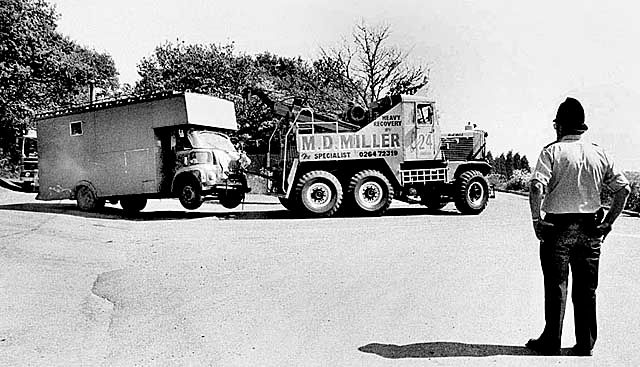
Some had lost everything they had. Parents where frantic in locating their children that had been taken into care. Vehicles had been taken to a ‘pound’ some 25 miles away and people had to go through further humiliation in reclaiming what was left of their homes.
Twenty-four of us took out a civil action against the Chief Constable of Wiltshire for the wrongs that were done to us that day. Nearly six years later at the High Court in Winchester, we won most of our case and were each awarded damages against the police. The Guardian said “Need to preserve pubic order does not permit the police to ride roughshod over the rights of ordinary people”. After a four month hearing, (during which we were made to feel like we were on trial), on the last day, the Judge made an order on court costs that, as we were getting legal aid, meant we got nothing.
What’s new!
As Lord Gifford QC, our legal representative, put it:
“It left a very sour taste in the mouth.”
To some of those at the brunt end of the truncheon charge it left a devastating legacy.
Things have never been the same again since the Beanfield. Throughout the rest of the year whether in small groups or at events, travellers were continually harassed.
It had defiantly changed us in many different ways. There was one guy who I trusted my children with in the early 80s – he was a potter, amongst other things. A nicer chap you couldn’t wish to meet. After the Beanfield I wouldn’t let him anywhere near them. I saw him, a man of substance, at the end of all that nonsense wobbled to the point of illness and evil. It turned all of us and I’m sure that applies to the whole travelling community. There were plenty of people who had got something very positive together who came out of the Beanfield with a world view of `fuck everyone’.
The berserk nature of the police violence drew obvious comparisons with the coercive police tactics employed on the miners strike the year before. Many observers claimed the two events provided strong evidence that government directives were para-militarising police responses to crowd control. Indeed, the confidential Wiltshire Police Operation Solstice Report released to plaintiffs during the resulting Crown Court case, states: “Counsels opinion regarding the police tactics used in the miners strike to prevent a breach of the peace was considered relevant.”
The news section of Police Review, published seven days after the Beanfield, stated:
“The Police operation had been planned for several months and lessons in rapid deployment learned from the miners strike were implemented.”
The manufactured reasoning behind such heavy-handed tactics was best summed up in a laughable passage from the confidential police report on the Beanfield:
“There is known to be a hierarchy within the convoy; a small nucleus of leaders making the final decisions on all matters of importance relating to the convoys activities. A second group who are known as the lieutenants or warriors carry out the wishes of the convoy leader, intimidating other groups on site.”
If the coercive policing used during the miners strike was a violent introduction to Thatcher’s mal-intention towards union activity, the Battle of the Beanfield was a similarly severe introduction to a new era of intolerance of Travellers.
Over 25 years later, some of us still suffer the consequences of this action.
Alan ‘Tash’ Lodge
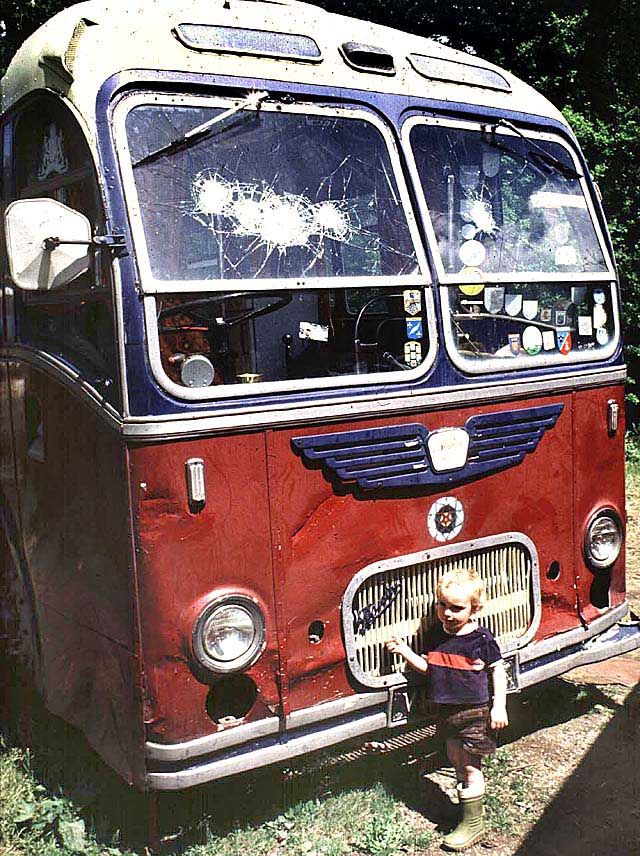
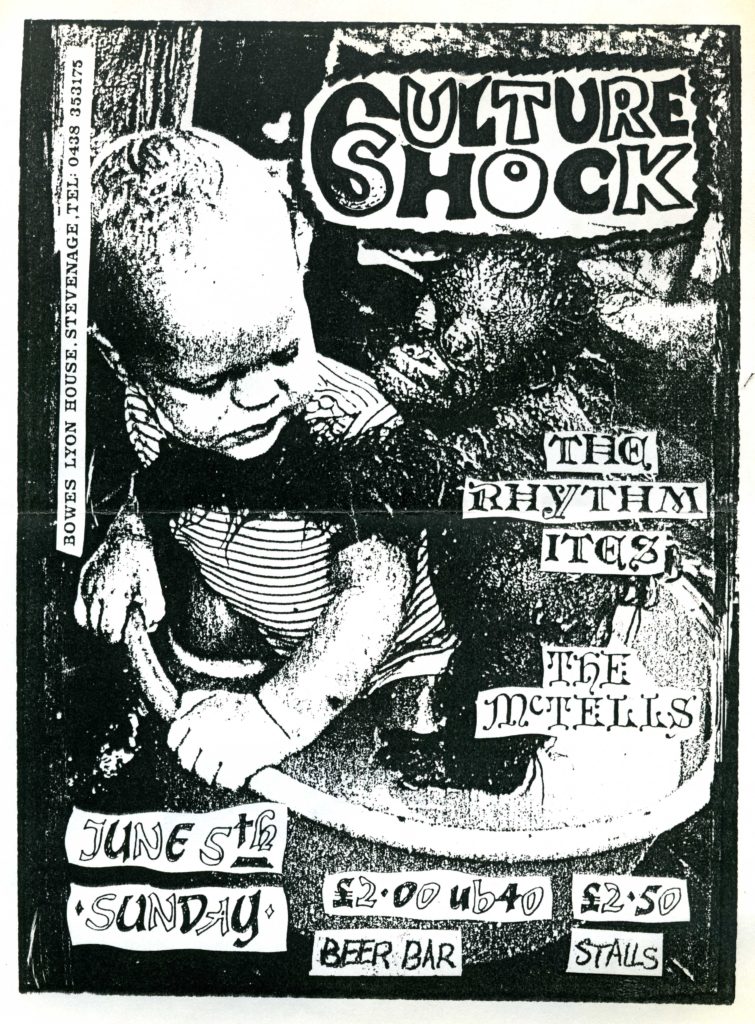
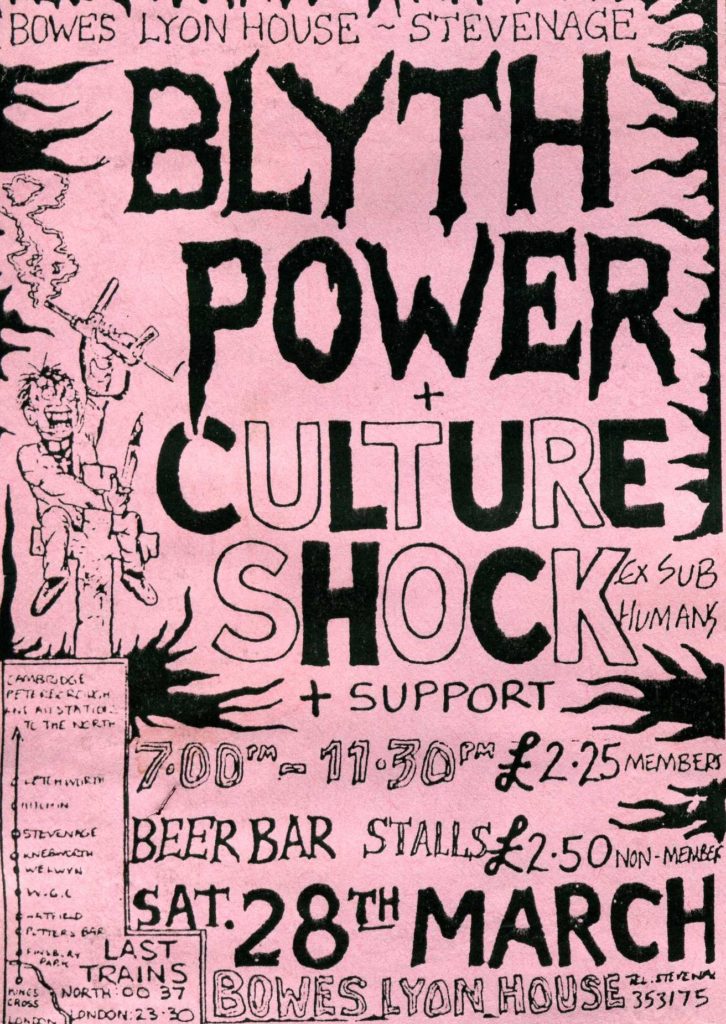

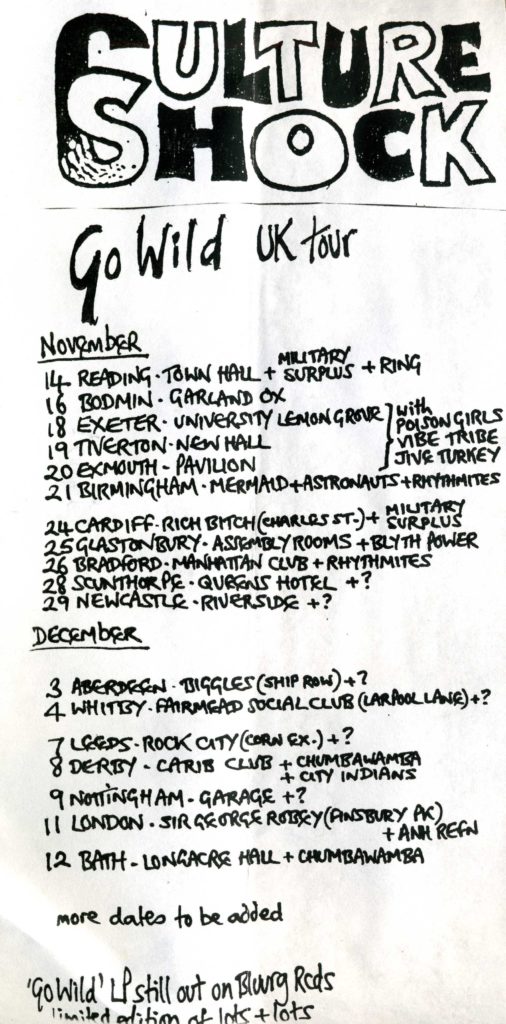
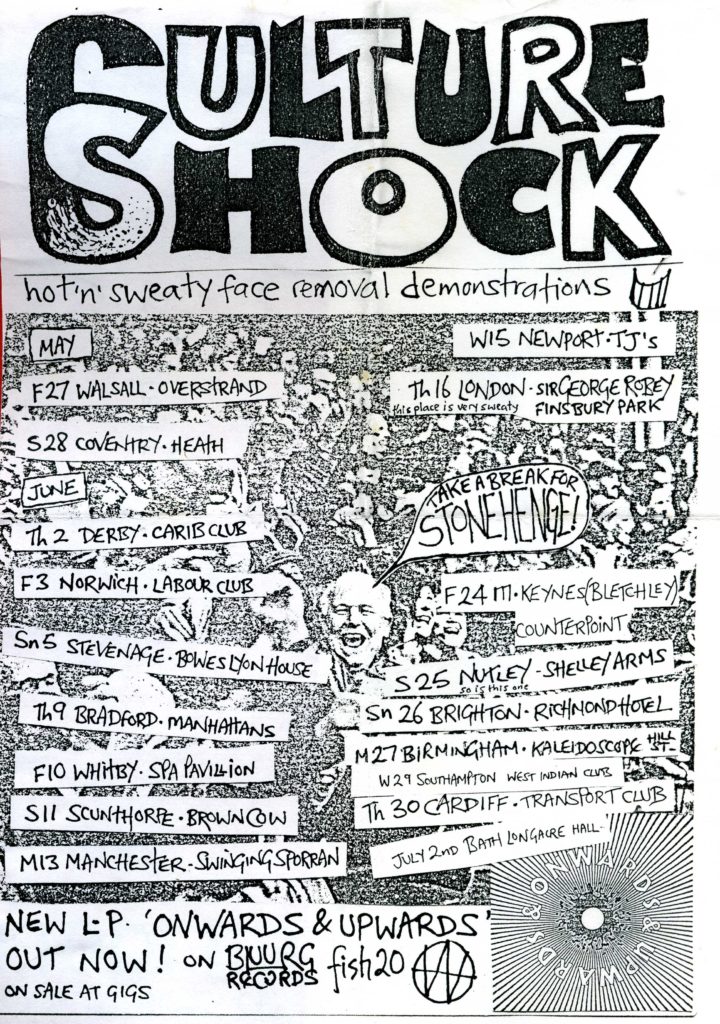
Paul
January 15, 2011 at 8:55 pmThanks very much. Wonderful music. I knew their albums, but never knew of these demo tapes.
David M
January 16, 2011 at 9:28 pmThe lovely folks at Active Distribution will be reissuing Culture Shock’s collected works May 1st. http://www.activedistributionshop.org/shop/
joe public
January 16, 2011 at 11:08 pmhey guys….i got all these tracks ripped from tapes as 224kbps and would be happy to send them to ya on disk???
also got live stowhill labour club, newport 05.06.86 and the hot and sweaty tape, along with all 3 psychological background tapes ….all as individual mp3s, if thats any use to ya….
thanks for keepin de spirit alive and all de best….
joe
Iain Aitch
January 18, 2011 at 11:02 pmI think I must have been at the gig you have posted the flyer for. Who on earth put the McTells on with those two? Mis-billing in the extreme! Haha.
Penguin • Post Author •
January 18, 2011 at 11:10 pmHey Ian, cheeky fellow…I’m pretty sure I got them that gig opening up for Culture Shock. Still as you mentioned maybe not my finest moment! The recording of the gig is here:
http://killyourpetpuppy.co.uk/post86/?p=21
I also have The McTells set from that gig but not sure if I have uploaded that. It will be in my big box of tapes. As is your compilation tape thingy with booklet…
Chris L
January 21, 2011 at 3:22 amNot really related to Culture Shock tho Citizen Fish are playing, but just wondering as no one has mentioned it before who is going along to the ‘anarcho punk’ 3-dayer Steve of Lost Cherees is putting on this weekend?
full details here: http://www.facebook.com/pages/Another-Winter-of-Discontent-Festival-2011-at-the-Gaff/174325925927614?v=info
I’ll probably go along tonight but definately on Saturday as it’s my birthday bash and no doubt on the Sunday n’all as the venue is just down the road from me. Only £8 each night I think so can’t go wrong there.
Who else is up for it? Mine’s a Kronenberg 😉
luggy
January 21, 2011 at 9:50 amThink I stuck something up about it a few months ago somewhere on here. Going on the Sunday, might go on the Saturday as well. Have a good birthday if I don’t make it that night.
Penguin • Post Author •
January 21, 2011 at 9:52 amI’m going saturday and sunday Chris. Meet you at yours saturday. I will ring you on the day for a time old bean.
luggy
January 21, 2011 at 4:45 pmApparently The Gaff has been sold to Costa Coffee & Sunday will be the last gig there. Shame, another good venue bites the dust. Maybe they’ll be selling the booze off cheap on the night though.
David M
January 22, 2011 at 7:59 pmHave a good one. Making too many trips to London of late (five last year), so thought it best to stay put in Aberdeen… least ’til next time;)
ciaran
February 8, 2011 at 3:40 pmNice one, brings back memories of a dusty summer fest at Treeworgy!
Nic
February 10, 2011 at 8:46 amTreeworgy: very dusty and an all-round good time!
(Although I seem to remember rumours that some people caught Dysentry!)
ciaran
February 11, 2011 at 4:52 pmwhen culture shock came on at treeworgy all I remember was a huge dust cloud rising up, one of those bands you just have to dance to!
dean bromley
February 12, 2011 at 1:20 ami would love a copy of that culture shock live stowhill labour club, newport 05.06.86. if you can put it up on rapidshare,mediafire etc it would be greatly appreciated. i am trying to get all i can from culture shock i am suprised there are not more live tapes floating around considering the amount of gigs they played.
scoey
February 15, 2011 at 4:00 ambrings back so many memories.it was hard back then trying to be yourself.the convoy & the festivals kept me alive.i didn’t have my own bus but grabbed a lift whenever i could.remember seeing culture shock many times.i was a crusty in those days.patches all over me homemade trousers.i did have a t/shirt but got ripped at one of the moshpits.they played on wango riley stage a lot.i still see dick.citizen fish played at the last fuk reddin.got some photos somewhere.
Paul
September 26, 2011 at 9:13 pmYou should really order the Culture Shock – Everything 3cd at Active Distribution. Great band!
jon active
January 27, 2012 at 7:54 pmMore information on Culture Shock at their website
http://www.cultureshock.me.uk/
Nikki
March 14, 2013 at 12:02 pmCulture Shock have reformed and are set to tour the UK this October!
R@ttus Napalm
April 20, 2013 at 8:09 pmGreat news that Culture Shock have reformed ! I hope to travel to see them this autumn. Four dates have been announced and can be seen here
http://www.rippingthrash.com./ under UK gig guide.
Ivana
October 5, 2013 at 12:06 pmI’ve met someone else who had been there… (c/o The Horsedrawn Camp), it was very emotional to witness those horrid memories…We have Culture Shock playing here Tuesday coming, can’t wait
Mhairi
October 7, 2013 at 10:34 pmI seen Culture Shock play last night, they were totally amazing
Jim
October 10, 2013 at 12:14 pmlive at Pivo Pivo in Glasgow this Sat 12th Oct.
back2front
October 10, 2013 at 6:21 pmI have the pleasure tomorrow night. It’s been 25 years since Cholderton Wood and the walk to Stonehenge the last time I saw them!
United
September 14, 2017 at 12:37 amBig thank from France for the sharing.